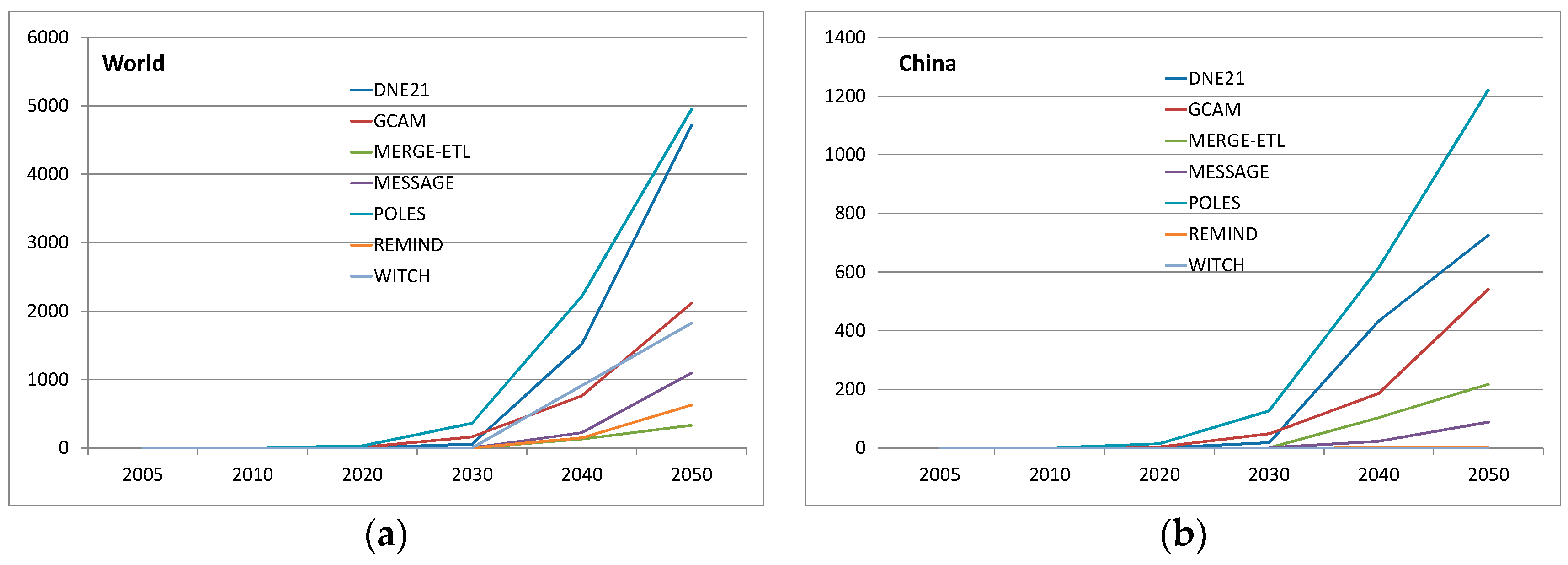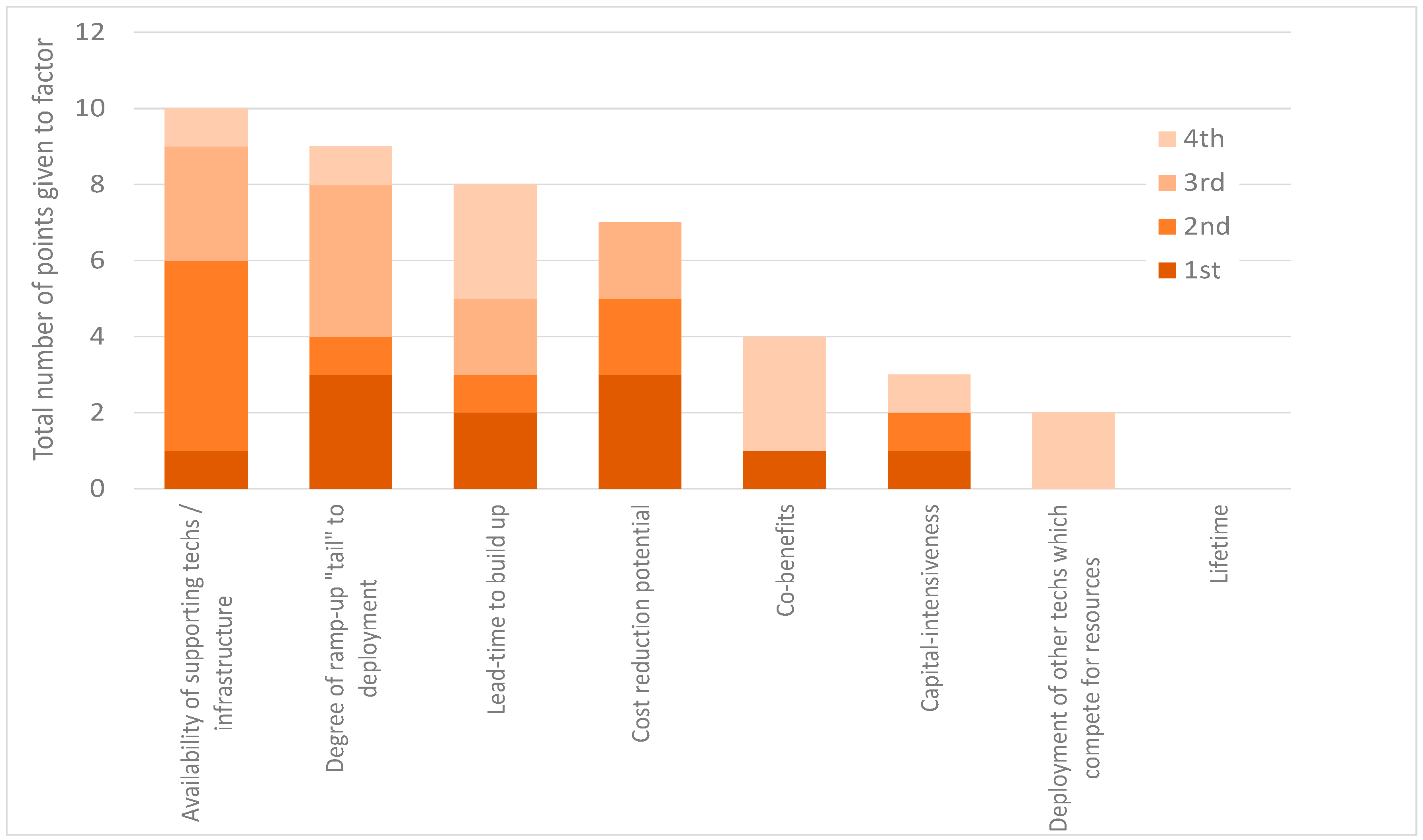Exploring the Feasibility of Low-Carbon Scenarios Using Historical Energy Transitions Analysis
Abstract
:1. Introduction
2. Insights from the Energy Transitions Literature
2.1. What do Low-Carbon Scenarios Imply in Terms of Energy System Changes?
- Eom et al. [13] show that, in a 450 ppm scenario, a quadrupling in the share of low-carbon energy in the period 2030–2050 (following relatively weak regional mitigation action up to 2030) could entail the deployment of 29–107 nuclear power plants globally every year (the upper end would occur in a case where there is no CCS). The lower end is in line with the highest rates achieved in the 1980s, but the high end is “unprecedented”. Solar deployment would increase by 50 to 360 times the 2011 capacity deployment rate of 3–4 GW (again, the high end occurring where no CCS were allowed) although it should be noted that more recent solar deployment rates have been in the tens of GW.
- Van der Zwaan et al. [14] also show that, across integrated assessment models (IAMs) in a scenario which has weak regional climate policies to 2020 and then global coordinated action aimed at achieving a 450 ppm atmospheric stabilisation of GHGs, there would be a very rapid ramp-up of low-carbon technologies, at rates (in terms of absolute GW deployed per year) far higher than have been achieved in recent history. This includes solar and wind deployment rates averaging around 150 GW per year in the period 2030–2050, compared to a few tens of GW per year to date.
2.2. How Feasible Are Such Energy System Changes?
2.3. What Are the Drivers, Barriers and Challenges of Rapid Energy Transitions?
- lock-in of industry actors to existing “regimes” through their technical base knowledge, core beliefs, mission, and industry-specific regulations [31];
- significant infrastructure, land and storage requirements for low-carbon energy technologies like CCS and renewables [33];
- the lack of co-benefits (such as greater portability, quality, reliability ease of use),of many low-carbon technologies which would offset their increased cost, at least without a carbon price or other incentives [19].
3. Background and Outcomes of Energy Transitions Workshop
- What are the most important factors to consider when assessing the feasibility of low-carbon scenarios?
- How can we achieve radical emissions reductions?
- Participants’ views on technology deployment and energy efficiency improvement rates in recent low-carbon scenarios.
3.1. Views on the Most Important Factors to Consider for Assessing Technology Penetration Rates
- Degree to which there has been a ramp-up “tail” period before rapid deployment
- Co-benefits of the technology beyond low-carbon
- Cost reduction potential of technology
- Lead-time to build and deploy technology
- Availability of complementary or supporting technologies/infrastructure
- Deployment of other low-carbon technologies which compete for resources
- Capital-intensiveness of technology
- Lifetime of technology
3.2. Views on the Most Important Factors to Consider When Assessing Energy System Transitions
3.3. Views on Rates of Supply-Side Technology Deployment and Energy Efficiency Change
3.4. Summary of Insights from Workshop
4. Methods to Apply Insights from Energy Transitions Analysis
4.1. Description of Analytical Methods
- How rapidly are particular energy technologies deployed in low-carbon scenarios and how do these deployment rates compare to historical levels of energy technology deployment?
- What is the pattern of energy technology deployment in low-carbon scenarios, particularly with respect to the initial ramp-up period (formative phase), and how does this compare to past technology deployment patterns?
- What is the overall rate of transition between primary energy resources in future low-carbon scenarios, and how does this compare to history?
4.2. Scenario Development and Rationale
- The first, named “2C_Original”, which does not have any specific technology growth constraints on the low-carbon supply side energy technologies, whose deployment is therefore only limited according to their relative cost. The only technology constraints are a limit on the share of total electricity generation made up by wind, of 50%, and the share of total electricity generation made up by total intermittent generation (mainly wind and solar) of 70%, to represent the increasing difficulty of handling intermittent generation, and in the case of wind to limit this technology from dominating, given the relatively low cost of onshore wind. These percentage limits are somewhat arbitrary as there are no firm limits on intermittent renewables electricity generation shares, particularly in the far future, with some scenarios modelling near-100% generation. This is used as a starting point in order to first assess whether any technologies grow at a rate greater than 20% per annum during any decadal periods between the year in which global mitigation action begins (2020) and the end of the projection period (2100). This 20% threshold appears to be at the higher end of technology growth rates as observed by Iyer et al. [17] (Test 1 in Table 3), and although this rate has been exceeded (see for example Kramer and Haigh’s [21] assessment that new primary energy sources have grown at 26% per annum in their early decades of development) it is used as a relatively conservative threshold given that the low-carbon transition sees many technologies growing simultaneously.
- The second, named “2C_Constrained”, which is created in order to constrain the growth rate of key energy technologies which are observed to exceed the 20% limit as part of the “2C_Original” scenario, therefore making them somewhat at odds with the historical sustained growth rates observed by Iyer et al. [17] (Test 1 in Table 3). Such diffusion constraints are common in optimisation models to prevent unrealistic growth or dominance of any one technology. Since CCS is not yet deployed, a growth constraint is meaningless without first specifying what initial level of deployment is allowed in each region—a “seed” value of 1 GW of CCS in each region is therefore specified, reflecting that initial deployment is likely to see one or two large-scale CCS plants of the order 0.5–1 GW (i.e., commercial scale) in each region.
- A third, named “2C_HighlyConstrained”, which is created in response to the application of all of the tests listed in Table 3 to the “2C_Constrained” scenario, and consideration of whether future low-carbon energy technology and energy resource patterns differ markedly from those patterns observed in the past. In particular, and as explained in greater detail in Section 5: the continued exponential growth of solar technologies beyond an initial growth phase is somewhat at odds with the past trends observed by Kramer and Haigh [21] (Test 5 in Table 3); the extent of wind deployment (in GW per EJ of total primary energy demand) in a given time duration, even with growth rates limited to 20% per annum, is significantly greater than for some other energy technologies as observed by Wilson et al. [23] (Test 3 in Table 3); and the rapidity of phase-out of coal as a primary energy resource is somewhat at odds with past trends as observed by Smil [11] and Gruebler [20] (Test 6 in Table 3).
5. Results from Application of Diagnostic Tests
5.1. Summary of Diagnostic Test Results as Applied to the Low-Carbon Scenarios
5.2. How Rapidly Are Low Carbon Technologies Deployed?
5.2.1. Test 1: Assessing the Rates of Deployment of Low-Carbon Technologies
5.2.2. Test 2: Comparing Future Technology Deployment Rates with Historical Rates
5.2.3. Test 3: Examining the Extent-Duration Relationship for Power Generation Technologies
5.3. What Is the Pattern of Low-Carbon Technology Deployment?
5.3.1. Test 4: Fitting Logistic Growth Curves to Power Generation Technology Deployment Levels
5.3.2. Test 5: Assessing Whether Future Technologies Break Kramer and Haigh’s Two Laws
- Initially technologies go through a few decades of exponential growth, corresponding to a growth rate of approximately 26% per annum, until they reach “materiality” (i.e., supplying around 1% of the primary energy mix). Note that this appears to be faster than the fastest observed sustained capacity additions of around 20% per year as appear in Iyer et al [17], which have been used to constrain the technology capacity deployment rates in Section 5.2.1. Given that Iyer et al interpret their collated historical rates of technology growth to produce an upper bound of a 15% per year growth rate (which they deem high), we consider our 20% growth constraint to be a reasonable, though potentially conservative, assumption.
- Beyond this, growth slows to linear growth typically at around 2%–4% per annum.
5.4. What Is the Rate of Transition between Primary Energy Resources?
Test 6: Assessing the Time Taken for Primary Energy Resource Shares to Rise and Fall
6. Implications and Conclusions
Supplementary Materials
Acknowledgments
Author Contributions
Conflicts of Interest
Appendix A. Note on the AVOID 2 Energy Transitions Workshop (16 October 2014, Imperial College London)
Appendix A.1. Session 1 Discussion Points:
- Speed of technology take-up depends on the technology in question:
- ○
- For example, CCS is a bulky, complex technology, which involves new infrastructure, project management, business models and significant financing.
- ○
- By contrast, solar PV is modular, can be deployed at small-scale and can be less capital intensive.
- ○
- Electric vehicles require only a change in drivetrain to existing car designs. This, combined with relatively short vehicle lifetimes, means that rapid take-up rates of EVs are plausible. 12% of new cars sold in Norway are EVs, incentivised by subsidies and other softer measures such as access to bus lanes, higher purchase taxes on conventional vehicles (i.e., very targeted policies to affect purchase behaviours)
- ○
- However, unless the grid is highly decarbonised, such as that in Norway, the well to wheel emissions for electric cars are similar to those of efficient internal combustion vehicles (this would be the case for the UK). Consequently, for there to be significant benefit in a rapid uptake of electric vehicles, over and above a stringent emissions standard for IC engine cars, not only would the grid need to have significantly more capacity, but it would need to be very low carbon.
- Speed of technology take-up depends on the tail before rapid take-off:
- ○
- Solar PV has had a very long tail of development and deployment leading to the recent significant increase in cumulative capacity. The same is true of wind.
- Success of a technology also depends on whether it can have benefits beyond just carbon reductions:
- ○
- These might be for example whether it can gain a wide variety of new applications (as with General Purpose Technologies such as the steam engine, though in practice it is not possible to tell in advance which technologies or combinations of technologies will become GPTs)
- ○
- Alternatively, it may have significant co-benefits (e.g., reduced air pollution, energy security) which make it attractive from a private/national perspective in the earlier stages of deployment, without considering its global social (climate) benefit.
- Businesses’ considerations will be critical in determining technology take-up rates:
- ○
- Businesses (e.g., refining) consider the time it takes to deploy technologies as well as the potential for cost reductions as technologies get deployed.
- ○
- In addition, rates of return for investment in new technologies are technology- and region-specific, reflecting these context-specific investment risks. The key to many business investment decisions is not so much technology-specific hurdle rates, but the forgone returns from alternative investments.
- ○
- The response of business is itself cultural specific. Anglo-Saxon nations tend towards high discount rates and legal frameworks that favour share-holder return. There are significantly different models in other parts of the world; for example share-ownership and short-termism are less dominant in Germany.
- ○
- Businesses also operate within a legal framework, so the use of emissions standards and other forms of regulation can rapidly change the business environment (though it is probably wise that politicians refrain from picking technology winners, and instead simply set the regulatory and emission standard framework within which industry must deliver/operate.
- Technology take-up rates cannot be considered outside of the social and political context:
- ○
- We are deeply locked-in to the technologies, institutions and norms of a fossil fuel energy system.
- ○
- Any radical replacement of fossil technologies will see significant destabilisation of this status quo.
- ○
- There needs to be a process of path creation for new and existing players in the energy system, in order to provide a transition path to a low-carbon system. An example of context-specific conditions is the rapid switch from town to natural gas (an established industry already looking for new opportunities, the specific era of governance with firms working closely with government) which saw very high levels of stranded assets but nonetheless succeeded.
- ○
- Particular policies which drive forward the technologies will be critical.
- ○
- End-use technologies have very rapid turnover rates (typically less than 10 years for cars, fridges, toasters etc.) and are therefore an exception to the issue of ‘lock-in’. Emission standards here could see very rapid transitions away from current levels of fossil fuel consumption—provided rebound issues were addressed.
- The “marginal economics” nature of energy-technology models may limit their usefulness in projecting fundamental energy system and energy demand changes.
Appendix A.2. Session 2 Discussion Points
- We are rapidly consuming our available carbon budget for the 21st century.
- A view was given that we cannot build low-carbon technology supply fast enough to make a significant impact on the current rate of emissions growth for many years to come, which highlights the importance of demand reduction.
- Consideration of requisite rates of decarbonisation needs to be clear about the probability of remaining below 2C.
- Requisite rates should not account for negative emissions technologies in all scenarios—exploring scenarios with and without negative emissions is better.
- ○
- However, if models represent bioenergy and CCS, then why not BECCS—perhaps better to consider limiting bioenergy and/or CCS as well/instead.
- ○
- One opposing argument is that there are a number of low-carbon technologies vying for bioenergy and the availability of biomass across all technologies needs to be considered.
- Energy demand reduction provides a feasible opportunity to make significant emissions cuts in the short term, but needs very effective policies.
- ○
- Example given of setting effective vehicle emission standards which could reduce emissions (considering turnover rates and some early scrappage) by 50% in 10 years.
- Should be more explicit consideration and explanation of underlying economic growth pathways that relate to each mitigation scenario
- ○
- The Shared Socioeconomic Pathways (SSP) work is beginning to address this point, since to date the socio-economic storyline for each Representative Concentration Pathway has been different, but the SSP initiative will allow matching of RCPs to different SSPs.
- Feasibility of decarbonisation rates cannot be considered without first considering what can be achieved in each sector by each technology, measure and policy.
- Many integrated assessment models do not have detailed representations of energy end-use technologies, and none have detailed representations of energy usage behaviour and detailed take-up patterns for end-use technologies. These limitations should be carefully considered in low-carbon scenarios.
- Low cost or even cost-saving energy demand reduction measures can help buy time for the implementation of low-carbon technologies. In addition, demand side is just as important as supply to energy security.
- With TIAM, which does have representation of energy demand technologies, it would be worthwhile considering what would happen in optimal scenarios when all cost-saving efficiencies are taken up, and in other scenarios where behaviour is not “optimal” in this narrow economic sense. A key question is defining how far real-world behaviour would deviate from this cost-optimality.
- Integrated assessment models mostly do not consider feedbacks from future energy systems to economic systems (other than through a marginal demand response as the price of energy rises with increased low-carbon technology share). In general no climate feedback to the economy’s output is modelled (although some projects are beginning to look at this—HELIX being one).
- It is worthwhile considering the impact of removing key technologies (not just BECCS) from the portfolio to assess feasibility and cost of low-carbon scenarios.
Appendix A.3. Session 3 Discussion Points
- Barriers:
- ○
- Wind at scale will require a lot bulkier capital investments;
- ○
- Wind not viable at small (household) scale and will face land constraints;
- ○
- Wind technology more mature, less room for cost reduction;
- ○
- Grid connections to wind could be a constraint;
- ○
- For solar, possible supply chain and material constraints need to be considered;
- ○
- Centralised generators do not favour decentralised technologies like solar.
- Overcoming barriers:
- ○
- Weather-based energy pricing to support solar and wind intermittency;
- ○
- Appliance design could be modified to handle intermittent generation;
- ○
- Smart systems with storage (e.g., from EVs & domestic thermal storage) would also help enable solar and wind;
- ○
- Specific policies have been successful in nurturing these technologies to rapid growth;
- Overall, none of the models’ rates of technology growth seem fundamentally infeasible, and solar in particular could grow faster, sooner.
- Large variations in base year figures noted between different models.
- Difficult to unpick what causes energy intensity reductions in each sector:
- ○
- How much is structural (e.g., shift to less energy-intensive industry);
- ○
- How much is technological (e.g., shift form ICE to EVs in transport);
- ○
- How much is demand reduction (e.g., travel less by car, switch lights off more frequently).
- Energy intensity is not a factor in itself to constrain, but the underlying factors need greater analysis.
- Overall, none of the rates of intensity improvements looked particularly infeasible, but need to understand the underlying drivers to assess this more thoroughly. e.g., electrification of end-use sectors could see significant energy efficiency savings, but need to consider what is driving electrification and how effective this driver is.
- Cannot consider the ramp-up rate of each technology by region in isolation, as supply chain capacity for a given technology can be considered a global resource, while the development of capacity (e.g., training engineers) in a given region probably implies trade-offs between technologies’ growth rates. Therefore need to consider what other technologies are being invested in globally and regionally, as these will compete for construction, skills, finance etc.
- Scenarios do not consider small nuclear reactors—just GW-scale.
- Overall, rapid post-2030 ramp-ups of nuclear and CCS look unrealistic unless there has been significant tooling up, investment in skills and infrastructure. Lead times for capital-intensive technologies such as this will be several years, potentially a decade—this must be accounted for.
- LCA (life-cycle assessment) carbon emissions for CCS are likely to be above 80 g CO2/kWh—and possibly much higher (unless technologies change and upstream capture of fugitive emissions is achieved). This places the LCA emissions of CCS at 4 to 20 times greater than the LCA carbon emissions for renewables and nuclear technologies. As a consequence, with more electrification the relative role of CCS in the power systems of Annex I countries is highly constrained by the available carbon budgets. So CCS is a viable transition technology for non-Annex I countries but much less so for Annex I countries.
- Modelling of this nature is not about predicting the future but more about identifying technology possibilities before considering how to support these technologies.
- Modelling develops heuristics—it helps us understand the system; the actual results need to be treated with considerable caution and continually sense checked.
- A number of considerations should be brought to bear when considering scenario feasibility:
- ○
- Technology costs and how these could develop with deployment (noting the considerable uncertainties around future costs);
- ○
- Technology co-benefits;
- ○
- Supply chain and material constraints;
- ○
- Trade-offs between technologies considering competition for skills, capital;
- ○
- Supporting technologies;
- ○
- Initial “tail” of deployment, including long lead-times for capital-intensive projects like CCS and nuclear;
- ○
- Policy effectiveness;
- ○
- Socio-political context accounting for lock-in to a fossil energy system.
- The demand side technologies, measures and policies are critical in achieving rapid emissions reductions, in many cases at low or negative costs, so should be considered more thoroughly.
- Important that models do not all “revert to a mean” so that there are no outliers—this may preclude important possible patterns of technology deployment (e.g., one technology showing significant dominance eventually). Against this, the massive increase in electricity generation as end-use sectors become electrified will probably require several different electricity generation technologies to be deployed.
Appendix B. Post-Workshop Questionnaire on Understanding the Feasibility of Energy System Transitions in Energy Technology Models
Introduction
- 1.
- Please state your level of expertise in energy transitions research (High, Medium, Low)
- 2.
- Please state your level of expertise in energy modelling (High, Medium, Low)
- 3.
- At the AVOID 2 workshop on energy transitions, a number of factors were discussed as potentially important in considering the real-world feasibility of different technology take-up rates. Which four of these factors are most critical (ranked 1: most critical, to 4) when undertaking a feasibility assessment of technology take-up rates?
- Degree to which there has been a ramp-up “tail” period before rapid deployment
- Co-benefits of the technology beyond low-carbon
- Cost reduction potential of technology
- Lead-time to build and deploy technology
- Availability of complementary or supporting technologies/infrastructure
- Deployment of other low-carbon technologies which compete for resources
- Capital-intensiveness of technology
- Lifetime of technology
- 4.
- On a scale of 1 (not at all useful) to 5 (very useful), how useful is it to consider (either in absolute terms, as % growth rates, or as shares of total technology capacity) the historical take-up rates of energy technologies when assessing the feasibility of particular low-carbon energy technology take-up rates in future mitigation scenarios? Please explain your answer.
- 5.
- In addition to factors (a–h) in question 1 above, as well as historical take-up rates of energy technologies, are there any other factors which should be considered when assessing the feasibility of technology take-up rates in mitigation scenarios?
- 6.
- Thinking beyond specific technology take-up rates and to broader energy systems, how useful (on a scale of 1: not at all useful, to 5: very useful) are the following methods to assess the feasibility of achieving future mitigation scenarios?
- Some analysis has considered the time taken for different energy sources to attain particular shares of total primary energy supply (either globally or regionally), as a guide to how rapidly low-carbon energy sources might attain given shares in the future.
- There has been some assessment of feasibility based on whether the mitigation scenarios involve a rapid increase in carbon prices over a short time period.
- Feasibility assessment has also considered whether absolute carbon prices reach particularly high levels.
- 7.
- Which other metrics could be useful in assessing the feasibility of achieving future energy systems in mitigation scenarios?
- 8.
- The following figures show the cumulative capacity deployed in different regions, using different energy-technology models, in the Ampere study (one of the major inter-model comparison projects to be included in the IPCC’s fifth assessment report). Underneath each figure the average annual growth rate over the period 2030–2050 is given (except for CCS, which is 2040–2050, since in many models no CCS is deployed by 2030). The particular scenario details are:
- “weak” country/region action in line with the lower (less ambitious) end of Cancun pledges to 2030, followed by global mitigation action aimed at achieving a 450 ppm concentration of GHGs;
- no specific details on technology R&D and planning before global mitigation action begins, though it may reasonably be assumed that current policies and R&D and demonstration programmes (e.g., for CCS) continue.






- 9.
- Figure B5 shows the change in energy intensity in the transport sector in different models from the Ampere study, in:
- a baseline scenario;
- a 450ppm scenario with immediate action (starting in 2010) and;
- a 450ppm scenario with immediate action and higher energy intensity improvements.


Appendix C. Logistic Growth
Appendix C.1. The Generalised S-Shaped Growth Model
Appendix C.2. Multiple Logistic Substitution
- Growth of new technologies occurs at logistic rates.
- Only one technology saturates the market at any given time.
- There is a non-logistic phase which connects the period of growth to its subsequent period of decline.
- Declining technologies fade away steadily at logistic rates uninfluenced by competition by new technologies.
- The raw data was converted into fractional shares of the market (where is the technology and is the year).
- These fractional shares were then transformed using the Fisher-Pry transform. This converts the S-shaped logistic growth into a straight line when plotted on a semi-log graph.
- The substitution curves correspond to the fractional market shares and cover all three of the substitution phases: logistic growth, non-logistic growth and logistic decline.
- By fitting a straight line to the growth and decline (if present) phases of each technology the parameters for each curve were estimated: (the characteristic growth time of technology ) and (the midpoint of growth/decline for technology ).
References
- Intergovernmental Panel on Climate Change (IPCC). Climate Change 2014: Working Group III: Mitigation of Climate Change; Cambridge University Press: Cambridge, UK, 2014. [Google Scholar]
- Kaldor, N. A Model of Economic Growth. Econ. J. 1957, 67, 591–624. [Google Scholar] [CrossRef]
- Gambhir, A.; Napp, T.A.; Hawkes, A.; McCollum, D.L.; Fricko, O.; Havlik, P.; Riahi, K.; Drouet, L.; Bosetti, V.; Bernie, D.; et al. Assessing the Challenges of Global Long-Term Mitigation Scenarios—AVOID 2 WPC2a; AVOID 2: London, UK, 2015. [Google Scholar]
- Loulou, R.; Labriet, M. ETSAP-TIAM: The TIMES integrated assessment model Part I: Model structure. Comput. Manag. Sci. 2007, 5, 7–40. [Google Scholar] [CrossRef]
- Loulou, R.; Labriet, M.; Kanudia, A. Deterministic and stochastic analysis of alternative climate targets under differentiated cooperation regimes. Energy Econ. 2009, 31, S131–S143. [Google Scholar] [CrossRef]
- AVOID 2 Climate Change Research Programme. Available online: http://www.avoid.uk.net/ (accessed on 12 December 2016).
- Bosetti, V.; Carraro, C.; Galeotti, M.; Massetti, E.; Tavoni, M. WITCH—A World Induced Technical Change Hybrid Model; Social Science Research Network: Rochester, NY, USA, 2006. [Google Scholar]
- Messner, S.; Strubegger, M. Model-based decision support in energy planning. Int. J. Glob. Energy Issues 1999, 12, 196–207. [Google Scholar] [CrossRef]
- Riahi, K.; Grübler, A.; Nakicenovic, N. Scenarios of long-term socio-economic and environmental development under climate stabilization. Technol. Forecast. Soc. Chang. 2007, 74, 887–935. [Google Scholar] [CrossRef]
- Riahi, K.; Dentener, F.; Gielen, D.; Grubler, A.; Jewell, J.; Klimont, Z.; Krey, V.; McCollum, D.; Pachauri, S.; Rao, S.; et al. Chapter 17—Energy Pathways for Sustainable Development. In Global Energy Assessment—Toward a Sustainable Future; Cambridge University Press: Cambridge, UK; New York, NY, USA; The International Institute for Applied Systems Analysis: Laxenburg, Austria, 2012; pp. 1203–1306. [Google Scholar]
- Smil, V. Energy Transitions: History, Requirements, Prospects; ABC-CLIO: Santa Barbara, CA, USA, 2010. [Google Scholar]
- IEA. World Energy Outlook 2012; OECD/IEA: Paris, France, 2012. [Google Scholar]
- Eom, J.; Edmonds, J.; Krey, V.; Johnson, N.; Longden, T.; Luderer, G.; Riahi, K.; van Vuuren, D.P. The impact of near-term climate policy choices on technology and emission transition pathways. Technol. Forecast. Soc. Chang. 2005, 90, 73–88. [Google Scholar] [CrossRef] [Green Version]
- Van der Zwaan, B.C.C.; Rösler, H.; Kober, T.; Aboumahboub, T.; Calvin, K.V.; Gernaat, D.E.H.J.; Marangoni, G.; Mccollum, D. A cross-model comparison of global long-term technology diffusion under a 2 °C climate change control target. Clim. Chang. Econ. 2013, 4, 1340013. [Google Scholar] [CrossRef]
- MacKay, D.J.C. Sustainable Energy—Without the Hot Air; UIT: Cambridge, UK, 2009. [Google Scholar]
- Riahi, K.; Kriegler, E.; Johnson, N.; Bertram, C.; den Elzen, M.; Eom, J.; Schaeffer, M.; Edmonds, J.; Isaac, M.; Krey, V.; et al. Locked into Copenhagen pledges—Implications of short-term emission targets for the cost and feasibility of long-term climate goals. Technol. Forecast. Soc. Chang. 2015, 90, 8–23. [Google Scholar] [CrossRef] [Green Version]
- Iyer, G.; Hultman, N.; Eom, J.; McJeon, H.; Patel, P.; Clarke, L. Diffusion of low-carbon technologies and the feasibility of long-term climate targets. Technol. Forecast. Soc. Chang. 2015, 90, 103–118. [Google Scholar] [CrossRef]
- Anderson, K.; Bows, A. Beyond “dangerous” climate change: Emission scenarios for a new world. Philos. Trans. R. Soc. Math. Phys. Eng. Sci. 2011, 369, 20–44. [Google Scholar] [CrossRef] [PubMed]
- Fouquet, R.; Pearson, P.J.G. Past and prospective energy transitions: Insights from history. Energy Policy 2012, 50, 1–7. [Google Scholar] [CrossRef]
- Grubler, A. Energy transitions research: Insights and cautionary tales. Energy Policy 2012, 50, 8–16. [Google Scholar] [CrossRef]
- Kramer, G.J.; Haigh, M. No quick switch to low-carbon energy. Nature 2009, 462, 568–569. [Google Scholar] [CrossRef] [PubMed]
- Höök, M.; Li, J.; Johansson, K.; Snowden, S. Growth Rates of Global Energy Systems and Future Outlooks. Nat. Resour. Res. 2012, 21, 23–41. [Google Scholar] [CrossRef]
- Wilson, C.; Grubler, A.; Bauer, N.; Krey, V.; Riahi, K. Future capacity growth of energy technologies: Are scenarios consistent with historical evidence? Clim. Chang. 2013, 118, 381–395. [Google Scholar] [CrossRef] [Green Version]
- DWIA Danish Wind Energy Association Information. Available online: http://www.windpower.org/en/ (accessed on 6 January 2017).
- Grad, P. Biofuelling Brazil: An Overview of the Bioethanol Success Story in Brazil. Refocus 2006, 7, 56–59. [Google Scholar] [CrossRef]
- Solomon, B.D.; Krishna, K. The coming sustainable energy transition: History, strategies, and outlook. Energy Policy 2011, 39, 7422–7431. [Google Scholar] [CrossRef]
- Grubler, A. The costs of the French nuclear scale-up: A case of negative learning by doing. Energy Policy 2010, 38, 5174–5188. [Google Scholar] [CrossRef]
- Arapostathis, S.; Carlsson-Hyslop, A.; Pearson, P.J.G.; Thornton, J.; Gradillas, M.; Laczay, S.; Wallis, S. Governing transitions: Cases and insights from two periods in the history of the UK gas industry. Energy Policy 2013, 52, 25–44. [Google Scholar] [CrossRef]
- International Energy Agency (IEA). World Energy Investment Outlook 2014; IEA/OECD: Paris, France, 2014. [Google Scholar]
- Johnson, N.; Krey, V.; McCollum, D.L.; Rao, S.; Riahi, K.; Rogelj, J. Stranded on a low-carbon planet: Implications of climate policy for the phase-out of coal-based power plants. Technol. Forecast. Soc. Chang. 2015, 90, 89–102. [Google Scholar] [CrossRef]
- Turnheim, B.; Geels, F.W. Regime destabilisation as the flipside of energy transitions: Lessons from the history of the British coal industry (1913–1997). Energy Policy 2012, 50, 35–49. [Google Scholar] [CrossRef]
- Mccollum, D.; Nagai, Y.; Riahi, K.; Marangoni, G.; Calvin, K.; Pietzcker, R.; van Vliet, J.; van der Zwaan, B. Energy investments under climate policy: A comparison of global models. Clim. Chang. Econ. 2013, 4, 1340010. [Google Scholar] [CrossRef]
- Element Energy. Infrastructure in a Low-Carbon Energy System to 2030: Carbon Capture and Storage—A Report to the Committee on Climate Change 2013; Element Energy: Cambridge, UK, 2013. [Google Scholar]
- Fouquet, R. Long-Run Demand for Energy Services: Income and Price Elasticities over Two Hundred Years. Rev. Environ. Econ. Policy 2014. [Google Scholar] [CrossRef]
- Li, F.G.N.; Trutnevyte, E.; Strachan, N. A review of socio-technical energy transition (STET) models. Technol. Forecast. Soc. Chang. 2015, 100, 290–305. [Google Scholar] [CrossRef]
- Geels, F.W.; Berkhout, F.; van Vuuren, D.P. Bridging analytical approaches for low-carbon transitions. Nat. Clim. Chang. 2016, 6, 576–583. [Google Scholar] [CrossRef]
- Trutnevyte, E.; Barton, J.; O’Grady, Á.; Ogunkunle, D.; Pudjianto, D.; Robertson, E. Linking a storyline with multiple models: A cross-scale study of the UK power system transition. Technol. Forecast. Soc. Chang. 2014, 89, 26–42. [Google Scholar] [CrossRef] [Green Version]
- AR5 Scenario Database. Available online: https://secure.iiasa.ac.at/web-apps/ene/AR5DB/ (accessed on 13 June 2015).
- Van Sluisveld, M.A.E.; Harmsen, J.H.M.; Bauer, N.; McCollum, D.L.; Riahi, K.; Tavoni, M.; van Vuuren, D.P.; Wilson, C.; Zwaan, B. Van der Comparing future patterns of energy system change in 2 °C scenarios with historically observed rates of change. Glob. Environ. Chang. 2015, 35, 436–449. [Google Scholar] [CrossRef] [Green Version]
- Rogelj, J.; McCollum, D.L.; O’Neill, B.C.; Riahi, K. 2020 emissions levels required to limit warming to below 2 °C. Nat. Clim. Chang. 2013, 3, 405–412. [Google Scholar] [CrossRef]
- Clarke, L.; Edmonds, J.; Krey, V.; Richels, R.; Rose, S.; Tavoni, M. International climate policy architectures: Overview of the EMF 22 International Scenarios. Energy Econ. 2009, 31, S64–S81. [Google Scholar] [CrossRef] [Green Version]
- Wiltshire, A.; Davies-Barnard, T. Planetary Limits to BECCS Negative Emissions—AVOID 2 Report WPD2a; AVOID 2: London, UK, 2015. [Google Scholar]
- Global Wind Energy Council Global Statistics. Available online: http://www.gwec.net/global-figures/graphs/ (accessed on 13 June 2015).
- Schilling, M.A.; Esmundo, M. Technology S-curves in renewable energy alternatives: Analysis and implications for industry and government. Energy Policy 2009, 37, 1767–1781. [Google Scholar] [CrossRef]
- Wilson, C.; Grubler, A. Lessons from the history of technological change for clean energy scenarios and policies. Nat. Resour. Forum 2011, 35, 165–184. [Google Scholar] [CrossRef]
- Kucharavy, D.; de Guio, R. Logistic substitution model and technological forecasting. Procedia Eng. 2011, 9, 402–416. [Google Scholar] [CrossRef]










| Fuel | 5%→25% Global Share |
|---|---|
| Coal | 35 years |
| Oil | 40 years |
| Gas | 55 years |
| Country | Technology/Fuel | Rate of Growth |
|---|---|---|
| France | Nuclear (PWR) | 19% per year (1977–1997), maximum rate 9 GW per year (1980) |
| Denmark | Wind | 20% per year (1977–2008) |
| Netherlands | Natural gas | 5% of primary energy in 1965 to 50% in 1971 |
| Area of Assessment | Description of Test | Previous Uses of Test |
|---|---|---|
| How rapidly are low-carbon technologies deployed? | Test 1: Comparison of future low-carbon technology growth rates to highest historically observed energy technology growth rates (around 20% per annum) | Iyer et al. [17] |
| Test 2: Comparison of the average annual additional capacity (GW/year) to historical values for different technologies (>50 GW/year for coal, 10–20 GW/year for gas, nuclear and wind, <5 GW/year for solar over the period 2000–2010, as shown in Section 5.2.2) | Van der Zwaan et al. [14] | |
| Test 3: Analysis of duration of deployment for a given level of installed capacity over the full technology lifecycle (as discussed in Section 5.2.3) | Wilson et al. [23] | |
| What is the pattern of low-carbon technology deployment? | Test 4: Assessment of how technology growth rates compare to a logistic growth profile (See Section 5.3.1) | Wilson et al. [23] |
| Test 5: Consideration of change in rate of growth of primary energy resources once they reach a material (~1%) share of primary energy (See Section 5.3.2) | Kramer and Haigh [21] | |
| What is the rate of transition between primary energy resources? | Test 6: Analysis of the overall energy transition in terms of primary energy shares using a multiple logistic substitution model. This type of model, described in Appendix C, describes the growth, saturation and decline of technologies over time as new technologies compete with existing technologies to take away their market share. (See Section 5.4) | Gruebler [20], Smil [11] |
| Scenario Details | 2C_Original | 2C_Constrained | 2C_HighlyConstrained |
|---|---|---|---|
| 21st century CO2 budget (GtCO2) and 2100 median temperature change | 1340 (2.0 °C) | 1340 (2.0 °C) | 1540 (2.1 °C) |
| Mitigation action | Global mitigation action from 2020, following weak regional action to 2020 | ||
| Description | 2 °C scenario with action delayed to 2020 | Based on the 2C_Original scenario with 20% annual growth rate constraints applied to some technologies | Based on the 2C_Constrained scenario with additional strict constraints to avoid breech of empirical rules |
| Constraint on supply side energy technologies | Intermittent (mainly wind and solar) electricity generation limited to 70% of total electricity generation, and wind to 50% of total electricity generation | Intermittent electricity generation constraints as per 2C_Original; 20% maximum growth on key technologies which exceed this in the 2C_Original scenario (CCS, solar and wind) | Intermittent electricity generation constraints as per 2C_Original; 20% maximum growth rate for all CCS technologies with a 1 GW seed; 20% growth constraint on solar reduced to 4% after 2040; 5% growth constraint on wind; Minimum capacity factor for unabated coal plants set to 70% for new technologies and 50% for existing technologies |
| Test | 2C_Original | 2C_Constrained | 2C_HighlyConstrained * |
|---|---|---|---|
| 1 (growth rates) | 20% maximum growth rate exceeded for some technologies | 20% growth rate limit imposed | 20% growth rate limit imposed |
| 2 (capacity additions) | - | Annual new capacity additions for solar and wind significantly exceed historically observed capacity additions as well as ranges observed in other IAM model projections. | Annual new capacity additions for all technologies are broadly in line with historically observed capacity additions. |
| 3 (extent of deployment in given time) | - | The fit of the extent-duration relationship of projected technologies broadly matches the historical fit shown in Wilson et al., except for wind where growth is too fast | Applying a growth limit of 5% per year to wind brings it closer to the historically observed extent-duration relationship. |
| 4 (shape of deployment time-profile) | - | The deployment profile for technologies follows a logistic growth shape with a slow ramp up from zero. | The deployment profile for technologies follows a logistic growth shape with a slow ramp up from zero. |
| 5 (growth rate transition from exponential to linear) | - | Projections for solar do not transition to a period of linear growth once materiality point (~1% of global primary energy) is reached. | Future solar growth transitions to a linear pattern once materiality reached. |
| 6 (rate of coal phase-out) | - | The rate at which coal is phased out is significantly faster than those rates observed in historical energy transitions. | Coal phase-out is still rapid but much slower than in the 2C_Original scenario. |
| Does the model solve? | Yes | Yes | No. Solves for a minimum 1540 GtCO2 budget. |
| CO2 price to 2100 (2005$/tCO2) | 118 (2030) 310 (2050) 3595 (2100) | 181 (2030) 480 (2050) 5512 (2100) | 322 (2030) 850 (2050) 9790 (2100) |
| Cumulative CO2 captured in BECCS to 2100 (GtCO2) | 895 | 805 | 792 |
| Cumulative mitigation cost 2012-2100 (2005$trillion), (% of cumulative global GDP) | 30.3 (1.0%) | 44.2 (1.4%) | 70.4 (2.2%) |
| Scenario | Technology | 2012–2020 | 2020–2030 | 2030–2040 | 2040–2050 | 2050–2060 | 2060–2070 | 2070–2080 | 2080–2090 | 2090–2100 | Average |
|---|---|---|---|---|---|---|---|---|---|---|---|
| 2C_Original | Biomass | 5.4% | −0.2% | −5.3% | - | - | - | - | - | - | - |
| Coal | 0.1% | −2.3% | −10.1% | - | - | - | - | - | - | - | |
| Gas | 0.0% | −1.2% | −9.5% | - | - | - | - | - | - | - | |
| Geothermal | −0.6% | 18.5% | 2.6% | 3.6% | 5.8% | 3.1% | 5.5% | 0.0% | 0.0% | 4.2% | |
| Hydro | 2.5% | 0.6% | 0.9% | 1.9% | 0.9% | 1.2% | 1.4% | 2.3% | 0.9% | 1.4% | |
| Nuclear | 6.1% | −0.8% | 0.6% | 2.8% | 2.8% | 1.7% | 0.8% | 0.5% | 0.3% | 1.5% | |
| Oil | −0.1% | −4.5% | −3.6% | −3.0% | 3.5% | 3.5% | 4.8% | 2.4% | 2.3% | 0.5% | |
| Solar | 14.8% | 3.2% | 8.4% | 3.2% | 11.1% | 5.3% | 13.4% | 4.6% | 4.6% | 7.4% | |
| Wind | 6.9% | 37.0% | 3.8% | 2.6% | 3.5% | 4.2% | 3.2% | 2.4% | 1.6% | 6.8% | |
| Biomass CCS | - | 78.6% * | 12.4% | 3.6% | 0.9% | 1.7% | 2.5% | 1.5% | 0.8% | 10.6% | |
| Gas CCS | - | 72.1% * | 8.8% | 0.7% | 2.8% | 6.4% | 3.4% | −1.1% | 3.3% | 10.2% | |
| 2C_Constrained | Biomass | 5.4% | 8.9% | −1.0% | −3.0% | −19.0% | −24.4% | −8.0% | 8.3% | 1.2% | −4.4% |
| Coal | 0.1% | −2.3% | −10.1% | - | - | - | - | - | - | - | |
| Gas | 0.0% | −1.2% | −9.5% | - | - | - | - | - | - | - | |
| Geothermal | −0.6% | 20.1% | 3.5% | 7.7% | 7.9% | 0.4% | 0.0% | 0.0% | 0.0% | 4.2% | |
| Hydro | 2.5% | 0.7% | 3.3% | 1.2% | 1.0% | 0.9% | 1.6% | 1.2% | 0.8% | 1.4% | |
| Nuclear | 6.1% | −0.8% | 1.4% | 3.4% | 1.9% | 1.3% | 0.6% | 0.5% | 0.3% | 1.5% | |
| Oil | 0.5% | 10.6% | −0.7% | 0.0% | −5.1% | 2.1% | 3.1% | 5.0% | 4.4% | 2.2% | |
| Solar | 14.8% | 4.7% | 14.3% | 18.8% | 2.0% | 2.2% | 6.5% | 5.0% | 3.4% | 7.6% | |
| Wind | 6.9% | 20.0% | 13.3% | 5.4% | 5.7% | 4.7% | 3.9% | 1.6% | 1.0% | 6.8% | |
| Biomass CCS | - | 27.2% *,^ | 23.4% ^ | 18.4% | 13.2% | 5.4% | 0.6% | −0.2% | 0.8% | 10.6% | |
| Gas CCS | - | 14.7% * | 25.0% ^ | 18.9% | 15.8% | 5.6% | 1.4% | 1.9% | 0.2% | 10.1% | |
| Key: <5% | 5% to 10% | 10% to 15% | >15% | - | - | - | - | - | - | - | - |
| Technology | Geography | Average Annual Growth Rate |
|---|---|---|
| Bioenergy | Global | 2% |
| Coal power | Global | 5% |
| Oil energy | Global | 7% |
| Natural gas power | Global | 7% |
| Hydropower | Global | <8% |
| Nuclear | Global | 11% |
| Wind | Global | 19% * |
| Scenario | Technology | Region | Growth Δt (in Years) | Decline Δt (in Years) |
|---|---|---|---|---|
| Historical | Biomass (traditional) | Global | - | −130 |
| Coal | Global | 130 | −80 | |
| Modern fuels (oil, gas, electricity) | Global | 90 | - | |
| 2C_Constrained | Unabated coal | Global | - | −17 |
| Biomass (without CCS) | Global | - | −202 | |
| Unabated gas and oil | Global | - | −127 | |
| CCS (all) | Global | 77 | −152 | |
| Renewables and nuclear | Global | 116 | - | |
| 2C_HighlyConstrained | Unabated coal | Global | - | −34 |
| Biomass (without CCS) | Global | - | −209 | |
| Unabated gas and oil | Global | - | −147 | |
| CCS (all) | Global | 42 | −440 | |
| Renewables and nuclear | Global | 200 | - |
© 2017 by the authors; licensee MDPI, Basel, Switzerland. This article is an open access article distributed under the terms and conditions of the Creative Commons Attribution (CC-BY) license (http://creativecommons.org/licenses/by/4.0/).
Share and Cite
Napp, T.; Bernie, D.; Thomas, R.; Lowe, J.; Hawkes, A.; Gambhir, A. Exploring the Feasibility of Low-Carbon Scenarios Using Historical Energy Transitions Analysis. Energies 2017, 10, 116. https://doi.org/10.3390/en10010116
Napp T, Bernie D, Thomas R, Lowe J, Hawkes A, Gambhir A. Exploring the Feasibility of Low-Carbon Scenarios Using Historical Energy Transitions Analysis. Energies. 2017; 10(1):116. https://doi.org/10.3390/en10010116
Chicago/Turabian StyleNapp, Tamaryn, Dan Bernie, Rebecca Thomas, Jason Lowe, Adam Hawkes, and Ajay Gambhir. 2017. "Exploring the Feasibility of Low-Carbon Scenarios Using Historical Energy Transitions Analysis" Energies 10, no. 1: 116. https://doi.org/10.3390/en10010116






